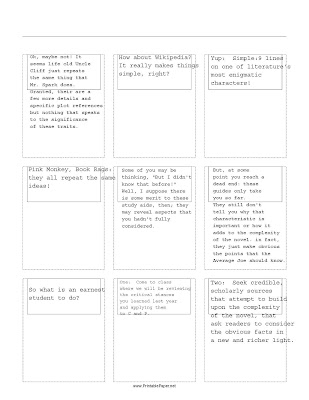1. The systematic way of working through the project and responding to the process could be quite helpful, especially if someone were to read through all of the posts before embarking on their own assignment. Waiting until you are stuck in the middle of your own personal quicksand is a bad time to go looking for help. I say this for teachers, not for students. Students will know how to do this, or they will be more flexible in their thinking about technology as a whole. Oh, to be of the digital age...
2. As for how I will use this particular blog in the future remains to be seen: I've been loyal to my old blog for several years now, using it as a forum for classroom discussions, etc. I might have my seniors watch the video here and hold a cyber discussion rather than the typical classroom response. We'll see...
3. How will I help others grow in the use of technology? Well, I can show my peers what I've created and even offer to help them make their own, but I'd risk stoning and public derision. More seriously though, I could create an inservice for my fellow teachers and lead them through the basics of the assignment. Maybe...
4. As for the success of the 23 Things format, I'll say this: over the past few summers I've learned about some really cool technology applications, and I think the increased awareness and savvy is notable on its own, but this summer's assignment was all about application. It demanded a new product that would draw upon all of those things learned in the past.
I used so many of the technology applications from past summers, this time in more authentic ways. Time and time again, I found myself going back to the 23 and 11.5 things pages, looking for reminders, instructions and details: What was that site called where we made the magazine covers? BigHuge Labs? Where were instructions for how to download to Utube?
These are just a few examples that spring to mind in these early morning hours...
I'd have to say though, that the greatest challenge came in the form of the assigned medium, the video. I spent more hours learning about Windows Movie Maker than anything else, period. The inspiration, the information gathering, the prewriting and planning: all of that came easy in relation to the actual production. Looking back at my posts, you can see all of the incarnations, and those were just the ones that I had the nerve to publish!
I hope this wont dissuade other teachers from creating their own productions or assigning them to students: the fun is in the learning! Students will find the assignment easy and natural, and teachers will just have to accept that they may not know all of the details, but that they can learn some of them along the way.





